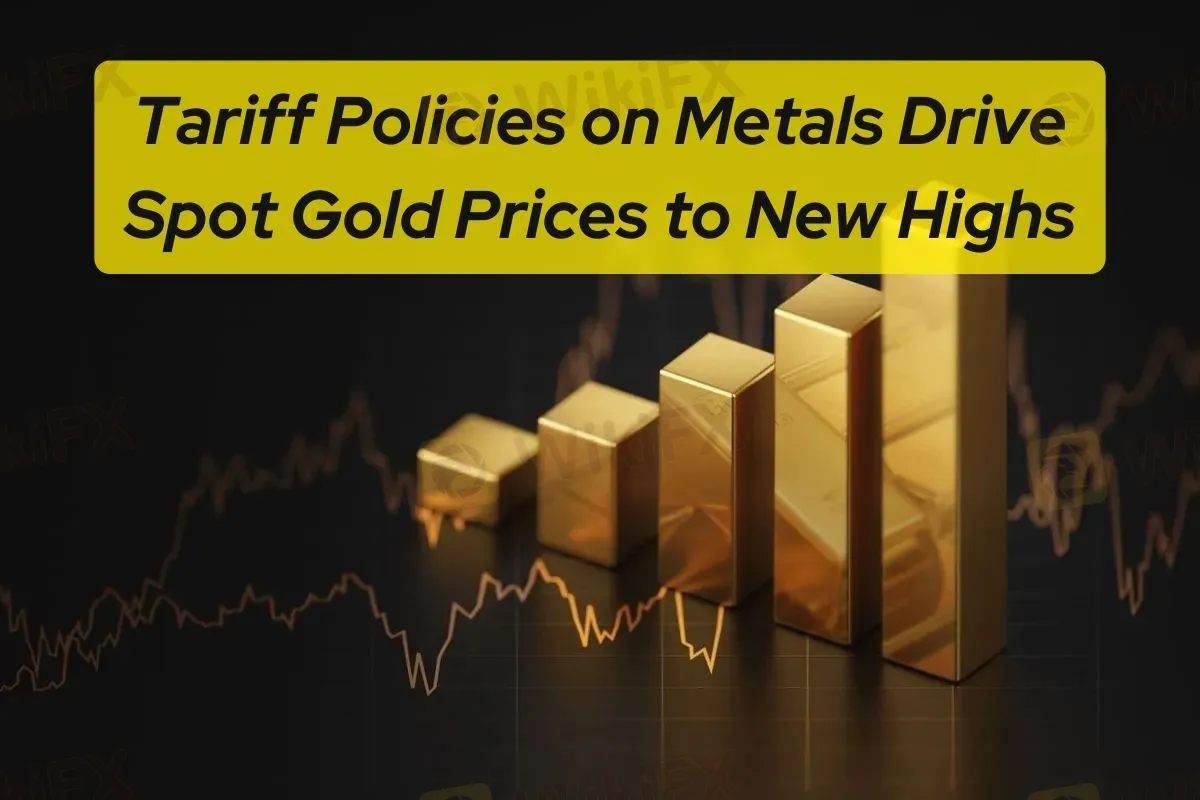Tariff Policies on Metals Drive Spot Gold Prices to New Highs
Abstract:Gold hits a record $2,926 as Trump’s metal tariffs, inflation fears, and geopolitical risks drive investor demand for safe-haven assets.

Gold prices have surged to $2,926 per ounce, setting a new all-time high as investors react to a confluence of economic uncertainties, inflationary pressures, and shifting global trade policies. The rally has been further fueled by market volatility, central bank actions, and the expansion of tariffs on metals by the Trump administration.
Rising geopolitical risks and concerns over a slowing global economy have also played a role in golds surge. Many institutional investors and central banks are increasing their gold holdings, reinforcing its status as a safe-haven asset amid economic turbulence.
Trumps 25% Metal Tariffs and Their Market Impact
US President Donald Trump recently signed an executive order expanding tariffs on steel and aluminum, applying a 25% duty on all imports of these metals, effectively canceling trade agreements with the European Union, the United Kingdom, Japan, and other key allies.
The new executive order builds upon the 25% steel and 10% aluminum tariffs imposed during Trumps first administration in 2018, but it removes previous exemptions, closes loopholes, and raises tariffs on downstream products beyond raw materials. The White House also hinted at further tariff measures on automobiles, semiconductors, and pharmaceuticals.
Market Reaction to Tariff Expansion
Following the announcement, the US dollar strengthened, attracting some buyers. At the time of writing, the DXY index rose by 0.05% to 108.37, reflecting a shift in investor sentiment towards the US currency as protectionist policies were enacted.
At the same time, the gold market responded positively, as increased tariffs heightened concerns about inflation, supply chain disruptions, and potential retaliatory measures from trade partners. Investors sought refuge in gold, leading to another spike in prices.
Other Key Drivers of the Gold Rally
- Federal Reserve Policy and Potential Rate Cuts:The Federal Reserve is expected to cut interest rates in 2025, which could weaken the dollar further and provide additional momentum for gold prices.
- Geopolitical Instability and Global Economic Concerns:Trade disputes, military conflicts, and economic sanctions have heightened global uncertainty, prompting investors to seek safe-haven assets.
- Central Banks and Institutional Demand:Several central banks, including China, Russia, and India, have increased gold purchases, reinforcing its role as a reserve asset.
Market Reactions from Experts and Institutions
Giovanni Staunovo, an analyst at UBS, stated, “We expect gold prices to receive further support and rise to $3,000 per ounce.” His outlook is based on continued demand from central banks, geopolitical uncertainties, and the expanding trade conflict, which are all factors that could drive gold higher.
Daniel Hynes, senior commodity strategist at ANZ, noted, “Gold could become entangled in retaliatory tariffs, which is already creating disruption in the physical market.” He emphasized that protectionist measures and ongoing trade disputes could impact supply chains, leading to increased demand for gold as a hedge against economic uncertainty.
Kelvin Wong, senior market analyst for Asia-Pacific at OANDA, expressed confidence in gold‘s upward momentum, stating, “I don’t see much possibility for a pullback at the moment unless we start seeing a strong rally in the U.S. dollar.”His view suggests that as long as the dollar remains stable or weak, gold will continue to find support from investors seeking safe-haven assets.
These expert assessments reinforce the notion that golds rally is far from over, with many analysts expecting sustained strength amid shifting global trade policies and market volatility.
Read more

How Is UBS Using Blockchain to Simplify Gold Investments?
UBS leverages blockchain to enable direct gold purchases, ensuring privacy, scalability, and interoperability for Swiss clients.

Forex Price Trend Prediction! | Come be a New Year Price Winner!
Become a New Year Price Winner by predicting the fluctuations of Forex!

The Yuan’s Struggle: How China Plans to Protect Its Economy
China introduced new measures on Monday to support its weakening currency, the yuan, amidst mounting economic and political pressures. The government announced plans to boost foreign exchange reserves in Hong Kong and ease borrowing restrictions for companies to improve capital flows.

$600B Gold Reserves in Pakistan's Indus River Could Reshape Economy
Breaking: Pakistan uncovers gold deposits worth 600B PKR in the Indus River, sparking hopes for economic revival and sustainable resource development.
WikiFX Broker
Latest News
EBSWARE Prop Launches Forex Trading Tournaments for Brokers
Key Risks and Downsides of Forex Trading Explained
How a Crypto Scam Cost Company Manager RM2.56 Million
TD Bank to Sell $14.9 Billion Schwab Stake, Repurchase Shares
Warning Against Agra Markets: Stay Cautious!
Scam Exposed: GlobTFX Deceives Another Investor
Trump tariffs: Retaliate or negotiate - what will US partners do next?
Hacker Who Breached SEC Account and Falsely Announced Bitcoin ETF Approval Faces Trial
Oil Prices Fluctuate as Iran and Trump Clash!
Best Regulated Forex Brokers Offering Daily Trading Signals
Rate Calc

